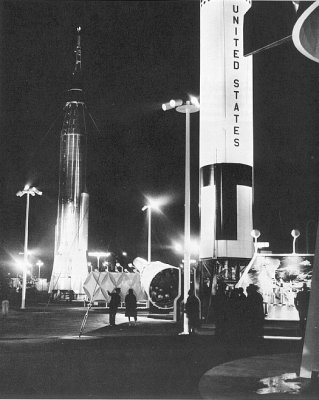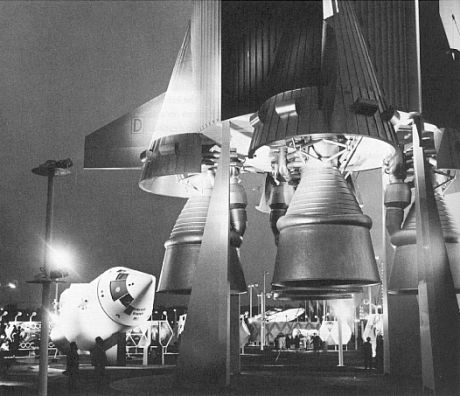|
A major
feature of the New York World's Fair is the two-acre United States
Space Park which includes, among other space-age hardware, the
Aurora 7 that carried Astronaut Scott Carpenter on the second
U.S. manned orbital flight.
The Space Park is co-sponsored
by the National Aeronautic and Space Administration, the Department
of Defense and the World's Fair. It includes the most imposing
array of full-scale U.S. rockets and spacecraft ever assembled
outside of Cape Kennedy, Florida.
Highlighting the park
is a full-scale "boattail" or propulsion section of
the massive Saturn V rocket which will send American astronauts
to the Moon. The model stands 52 feet tall, measures 33 feet
in diameter and is the bottom section of the 282-foot tall Saturn.
Among the spacecraft
shown are the Tiros and Nimbus weather satellites; Syncom, Telstar,
Relay and Echo communications satellites; Explorers for near-Earth
space investigation; the orbiting observatories; Rangers and
Surveyors for unmanned lunar exploration, and Mariner II, the
world's first successful Venus probe. Also in the group are the
Canadian-built Alouette, the British Ariel I, and Discoverer
XIV, the first satellite recovered from orbit by aircraft when
it re-entered the Earth's atmosphere.
Towering over the two-acre
exhibit is a Titan II-Gemini launch vehicle and its two-man spacecraft.
The
Titan II booster, 110 feet high, stands with the Gemini capsule
attached on top just as it will be on the launch pad at Cape
Kennedy.
Surrounding the Titan
II-Gemini are full-scale models of the Apollo Command and Service
Modules which will carry American astronauts to the moon, the
Lunar Excursion Module, and two-man Gemini spacecraft.
Other full-scale exhibits
in the Park are the Atlas-Mercury and Thor-Delta rockets, and
X-15 rocket-powered research aircraft and the Agena rocket.
A biosatellite spacecraft
illustrates future missions to explore the effects of the space
environment on animal and plant tissues.
The NERVA, or Nuclear
Engine for Rocket Vehicle Application, is shown in one-quarter
scale, and the SNAP-8 (Space Nuclear Auxiliary Power) is represented
in one-twelfth scale. A 1/48th scale model of the Titan III C
launch vehicle is also shown.
TITAN
LAUNCH VEHICLES
Titan
II, a two-stage U.S. Air Force booster, has been chosen by the
National Aeronautics and Space Administration to launch the Gemini
two-man spacecraft. Its first stage develops about 430,000 pounds
of thrust at sea level. The second stage develops about 100,000
pounds of thrust at altitude. Titan II stands 90 feet tall and
can place a spacecraft weighing about 7,000 pounds into orbit
around the Earth. It is 10 feet in diameter and uses storable
liquid propellants that burn on contact with each other. Thus
the Gemini launch vehicle can be fueled well ahead of launch
and need not be drained if a launch is postponed.
Modification
of Titan II for the Gemini program include development of a malfunction
detection system, duplication of vital systems, and increased
astronaut control of the vehicle.
A full
scale model of Titan II with a Gemini spacecraft mounted on top,
110 feet tall, is on display in the U.S. Space Park.
Titan
III is under development as a standard space launch system and
part of the National Launch Vehicle Program. It is the first
launch system developed by the Air Force from the outset as a
space booster. Capable of performing a variety of manned and
unmanned space missions in the next decade, Titan III, in it's
"C" configuration, is a three-stage, 103-foot-tall
vehicle developing about 2.5 million pounds of thrust.
Titan III is based on Titan II, modified principally
by strapping two large solid-fuel rockets to its sides and adding
a liquid-propellant third stage. It will be able to place 5,000
to 25,000-pound payloads in low altitude orbits, 10 tons in a
100-nautical mile orbit, or 13,000 pounds in a 1,000-nautical
mile orbit.
It will be used to launch the Air Force Manned
Orbiting Laboratory (MOL).

PROJECT
GEMINI
The
next major step after Mercury in the United States manned space
flight program is Project Gemini. This project's goals are:
To
determine man's performance and behavior during orbital flights
for as long as two weeks.
To
develop and perfect techniques for orbital rendezvous and docking,
the bringing together and coupling of craft in orbit;
To
carry out scientific investigations of space that require participation
and supervision of men aboard a spacecraft.
The
Department of Defense and NASA have agreed on joint arrangements
for the planning of experiments, the conduct of flight tests,
and the analysis and dissemination of results.
The
two-man Gemini spacecraft externally resembles the Mercury spacecraft.
It is 1 1/2 feet wider than Mercury at the base and lengthened
proportionately. It provides about 50 percent more cabin space
than Mercury and weighs about 7,000 pounds. Two men will pilot
the Gemini spacecraft.
Gemini
components will be outside the crew compartments and arranged
in easily removable units, thereby facilitating check-out and
maintenance.
Included
in Gemini equipment are docking apparatus for coupling with another
vehicle in space; a life support system for maintaining pressure,
temperature, and atmospheric composition of the crew cabin; instruments
to collect, transmit, and record data on conditions of the spacecraft
and astronauts; guidance and controls systems operating in conjunction
with computer to aid in navigation, rendezvous with another craft,
entering Earth's atmosphere, and landing; radar to aid in rendezvous
operations; and a landing and recovery system including a small
parachute to stabilize the craft, the paraglider mechanism, landing
gear, and recovery aids such as tracking beacons, flashing lights,
and two-way voice radios.
Ejection
Seats
-- Gemini will have no escape tower. Instead, each astronaut
will have an ejection seat (similar to that used in a fighter
aircraft) for escape during launch or for emergencies in the
recovery phase.
Adapter
Section
-- The two-piece adapter section is attached to the heat shield
at Gemini's base. The adapter section is 7 1/2 feet in diameter
at the top, 7 1/2 feet long, and 10 feet in diameter at its base.
It weighs about 2,200 pounds. It is made up of the equipment
and retrograde modules. As an aid in distinguishing the Gemini
parts, the crew section has been designated the re-entry module.
The
equipment module contains fuel, fuel cells, oxygen for breathing
and a propulsion system for orbital attitude control (orientation)
and maneuvers. The retrograde module, sandwiched between the
equipment and re-entry modules, contains the braking rockets
that decelerate Gemini and enable it to descend from orbit. It
also contains a propulsion system to aid in orienting and maneuvering
the craft.
The astronauts jettison the equipment module
during preparation for return to Earth. They discard the retrograde
module just before entry into the atmosphere.
To Land Like and Airplane -- Gemini flights will employ parachutes for landing.
In later flights the parachutes may be replaced by a 45-foot
wide wedge-shaped paraglider.
The paraglider will be part of the equipment
of the re-entry module, the only part of Gemini designed to return
to Earth. The device, deployed at about 40,000 feet, will enable
the astronauts to maneuver the module to any desired landing
point within a 20-mile radius.

ORBITAL
RENDEZVOUS
Phase
1--Launch and Insertion Into Orbit -- In the Gemini orbital rendezvous
mission, an Atlas will first launch an Agena rocket, modified
to link up with the Gemini spacecraft, into a near-circular orbit.
Ground stations will track Agena and determine the best time
to launch Gemini. Later, a Titan II will propel Gemini into an
elongated orbit with an altitude generally lower than that of
Agena but with apogee (highest altitude) at the same altitude
of the Agena orbit.
Phase
2--Closing
-- As soon as Gemini's radar acquires Agena, the so-called closing
phase of rendezvous begins. Radar information is fed into Gemini's
computer which tells the pilots which rockets to fire and when
and how long they must operate them to keep the craft stabilized
and gain on their target. When the two craft are about 20 miles
apart, the astronauts are expected to sight Agena and supplement
radar information with visual observation. A high-intensity flashing
light on Agena will help the astronauts keep their target in
sight. By the end of the closing phase, Gemini and Agena will
be 10 to 100 feet apart and traveling in the same orbit.
Phase
3--Docking
--The final phase of rendezvous is docking, the link-up of the
two vehicles. In this phase, much of the sensing, computing,
and decision requirements are within the capability of man. Using
visual observation, the astronauts will carefully maneuver Gemini
into contact with Agena. They are aided by an aiming bar on the
Gemini spacecraft and a notch in the rocket's receiving cone.
As
they near their target, the astronauts must reduce the relative
velocities between the two craft to less than 1 1/2 miles per
hour, although both are whirling around the Earth at about 18,000
miles per hour. Moreover, they must align the conical nose of
their craft with the docking socket of the Agena.
They
will accomplish this by using the attitude controls to pitch
Gemini (move its nose up or down), yaw the craft (turn its nose
to the right or left), or roll it around the long axis, as conditions
demand.
Docking
will be accomplished when the cone-shaped nose of Gemini is gently
nudged into the matching slot of the Agena. Coupling of the craft
will be automatic, and the astronauts will be able to operate
the joined vehicles as a single unit, adding the Agena's propulsion
system to that of the Gemini spacecraft.
At
the conclusion of their mission, the astronauts will detach Agena
and jettison the equipment module. Then, they will turn the spacecraft
around, fire the retrorockets to slow down and descent to Earth,
and discard the retrograde module.
Gemini
Crew May Step Out Into Space -- During advanced stages
of the Gemini program, its pressure-suited crew may open the
hatches and emerge from the spacecraft while in orbit. Moreover,
they may push themselves from the craft, and appear to float
in space as they speed around the Earth at about 18,000 miles
per hour. For this operation, they will be tethered to the craft
to insure their return. Gemini will store sufficient oxygen to
re-fill its cabin when the astronauts return.
This
experiment will help pave the way for future operations in which
man can make repairs, assemble orbiting stations, and perform
other functions in space.
Source: Fair
Publication: "Science at the Fair"
Photos by
Peter A. Leavens
|

